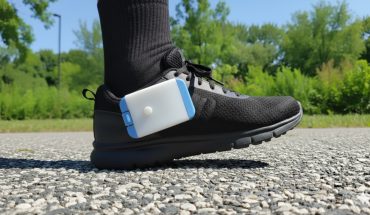Ships are the engine of global commerce; more than 80 per cent of global cargo is carried by massive ocean-going ships. At any given time, some 50,000 container ships, tankers and freighters are on the high seas.
It’s a vital global industry, but with lethal hidden costs.
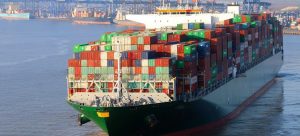
A cargo-laden container ship approaches a port. At any given time, some 50,000 container ships, tankers and freighters are on the high seas. Image © IMO.
In 2023, maritime trade volumes soared past 12 billion tonnes: racks and containers and boxes and pallets chock full of pretty much every kind of thing you’ve ever bought are on board.
International shipping is also responsible for three per cent of global greenhouse gas emissions. Three per cent may not sound like a lot, but if the shipping sector were a country, it would be the world’s sixth largest emitter — between Germany and Japan.
As global shipments increase, so, too, their emissions.
But a Canadian woman is playing an important part in reducing those deadly ship emissions with a newly developed technology based on a process that’s been around for billions of years.
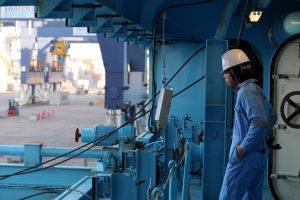
A seafarer on board a ship at Felixstowe Port in England. Many large ocean-going ships use heavy fuel oil, which emits lots of CO2, a major contributor to climate change. Image © IMO.
Many large ocean-going ships use heavy fuel oil, which emits lots of CO2, a major contributor to climate change, but also other potentially lethal pollutants like sulphur oxides, nitrogen oxides, and black carbon, a particularly dirty particulate matter that comes from incompletely burned fuel oil.
So the shipping industry has been under tremendous pressure to reduce its global carbon footprint. After years of discussion and negotiation, member countries of the International Maritime Organization have agreed that shipping should be net-zero by 2050, with a 20-to-30 per cent reduction in emissions in just five years!
The IMO is targeting large ocean-going ships exceeding 5,000 gross tonnes, which are responsible for about 85 per cent of carbon dioxide emissions from the marine shipping fleet. Formal adoption is still required later this year, but roughly 97 per cent of the world’s merchant shipping fleet by tonnage are in agreement now.
They’re relying on innovative new ideas and effective new technologies to play a major role in solving the shipping emissions dilemma.
But today’s battery technology does not provide enormous cargo vessels with enough power to cover long distances. Nuclear propulsion has also been considered, but of course there are risks and fears associated with this controversial idea.
Alternative zero-emissions fuels, such as hydrogen and ammonia, are being developed but no vessel of any size is ready to use the new cleaner fuel source today.
Wind propulsion, solar-assisted shipping, and onboard carbon capture are other technologies being considered.
And that’s where a Canadian woman is making waves.
 Alisha Fredriksson and her partner Roujia Wen have launched Seabound, a tech startup company based in the U.K. that’s developed a retrofittable carbon capture system that traps the CO₂ emitted from ship exhausts.
Alisha Fredriksson and her partner Roujia Wen have launched Seabound, a tech startup company based in the U.K. that’s developed a retrofittable carbon capture system that traps the CO₂ emitted from ship exhausts.
Housed in one or more standard shipping containers – of course – their invention takes the harmful exhaust from a ship’s engine and puts it through a techno-accelerated version of a billion-year-old natural ‘cleaning’ process.
Rather than being expelled into the atmosphere, engine fumes are funnelled into a large high-pressure chamber filled with small pebbles of calcium oxide. Through a natural chemical reaction, the pebbles absorb the CO2, turning it into calcium carbonate – aka limestone – and storing it much like the ocean floor has chemically absorbed carbon dioxide throughout much of Earth’s history.
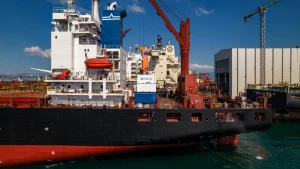
The Seabound system is housed in a standard shipping container. Depending on the amount of CO2 to capture, more than one unit can be installed. Seabound image.
Because the Seabound system fits into standard shipping containers, it can be adapted to different sized vessels.
When a ship carrying the Seabound decarbonization system docks, the limestone can be used as a building material or broken down to make new pebbles and pure CO2, which can either be buried underground or sold to companies to produce electro-fuels.
With their self-declared mission to tackle the climate crisis by controlling exhaust emissions and decarbonizing the maritime industry, Fredriksson and Wen have rapidly developed their company, testing and deploying in just the first two years of operation several onboard carbon capture systems, successfully capturing up to 80 per cent of CO₂ emissions on a 3,200 TEU container ship (that’s a medium-sized vessel, carrying some just over three thousand container units or their equivalent; super-size ships can carry 20,000 TEUs).
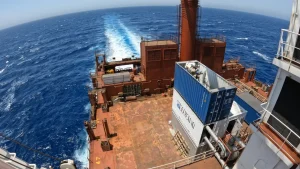
Seabound has completed trials with leading shipping companies, including as STAX and Lomar, during which they say 90% of the CO2 coming from the ships’ exhaust was captured. Seabound image.
Additional carbon capture trials of the Seabound system were underway at the busy Port of Los Angeles earlier this year.
At the same time, a leading international maritime emissions capture and control company, STAX Engineering, announced $70 million in funding along with the integration of its system with that of Seabound.
After pollutants are scrubbed and filtered by STAX technology, the ship’s exhaust is directed through Seabound’s capture unit, where the carbon and sulphur emissions are isolated and stored. Clean air enters the atmosphere. Captured CO₂ is safely offloaded, sequestered or reused.
(STAX, by the way, marked the International Day for Women in Maritime this year by drawing attention to the women working in the industry by operating an all-woman-crewed barge. Organizers noted that in an industry where it is uncommon to see two women on the same vessel, an all-woman crew – as many as 30 people are needed – is a sign of where the industry is heading.)
Seabound’s founders also see the industry heading towards a future where shipping can achieve zero-emissions operations. Their technology is already pointing the way to effective in-voyage carbon management so those valuable cargo-laden ships can keep sailing and reduce their climate and health-related impacts.
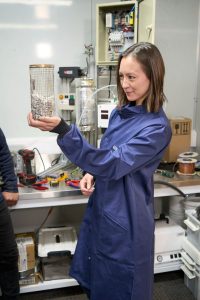
Canada’s Alisha Fredriksson was nominated for a Young Inventors Prize from the European Patent Office for her collaborative work on a carbon capture system that reduces ship emissions.
In that light, Alisha Fredriksson, as CEO and co-founder of the carbon capture company, was named the winner of the Nor-Shipping 2025 Young Entrepreneur Award, joining a prestigious list of former title holders, all of whom were under 40 when they were honoured.
Nor-Shipping is a global association and convention organizer for the world’s shipping industries. Every two years it holds a global event for key policy and decision makers from across the world; it last took place in Oslo, Norway in June of this year.
And the Seabound entrepreneur is being celebrated by the Canadian Intellectual Property Office, which posted recently how proud folks there are “to see Canada’s Alisha Fredriksson nominated for a Young Inventors Prize from the European Patent Office for her collaborative work on a carbon capture system that reduces ship emissions”.
For Fredrikson, peer recognition of her accomplishments is a welcome but not unfamiliar experience.
Born in Hungary to a Swedish father and Chinese mother, it’s said she was always a curious and energetic child. She enjoyed beading and gymnastics, and at an early age here in Canada, she started up her own jewellery business, showing her homemade wares to folks in her Vancouver neighbourhood.
That was in-between her exercise routines and gymnastics practices; she would go on to compete as a senior national level athlete, ranking as British Columbia’s Provincial Champion for six consecutive years.
As a student at Vancouver’s Prince of Wales Mini School (a special enriched public high school program), Fredrikson won scholarships and a spot on a unique Students on Ice Youth Antarctic Expedition, where for two weeks, she sailed around the Antarctic with some 90 other students, scientists, and polar ambassadors to see and study climate change in the real world. Following further studies in India, work with an electro-fuel company called Liquid Wind and others, she would eventually set her course with Roujia Wen as co-founder of Seabound.
Wen’s background is in mathematics, computer science, and physical sciences, and she’s gained R&D experience working in materials, fluid dynamics, and particle physics. Before Seabound, she built machine learning products at Amazon’s Alexa AI, and completed a master’s degree in Theoretical Physics at the University of Cambridge.
The success these two women have realized in early trials and tests of their shipboard carbon capture technology is setting the course for a decarbonized shipping industry that hopes to meet the all-important zero emission goal it set for itself – and for the planet.
-30-



